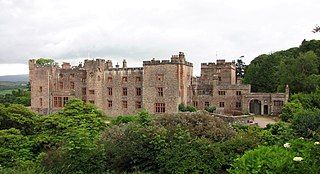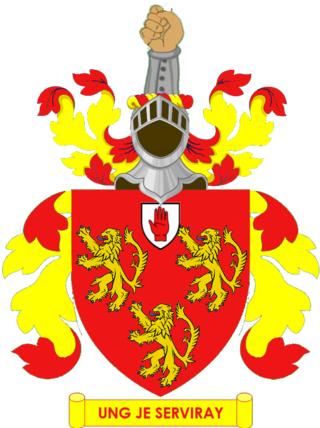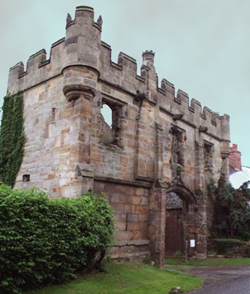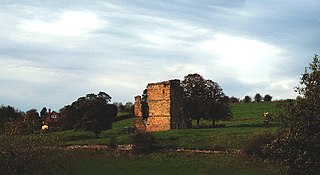
Raby Castle is a medieval castle located near Staindrop in County Durham, England, among 200 acres (810,000 m2) of deer park. It was built by John Neville, 3rd Baron Neville de Raby, between approximately 1367 and 1390. Cecily Neville, the mother of the Kings Edward IV and Richard III, was born here. After Charles Neville, 6th Earl of Westmorland, led the failed Rising of the North in favour of Mary, Queen of Scots in 1569 Raby Castle was taken into royal custody. Sir Henry Vane the Elder purchased Raby Castle in 1626 and neighbouring Barnard Castle from the Crown, and the Earls of Darlington and Dukes of Cleveland added a Gothic-style entrance hall and octagonal drawing room. From 1833 to 1891 they were the Dukes of Cleveland and they retain the title of Lord Barnard. Extensive alterations were carried out in the 17th and 18th centuries. It is famed for both its size and its art, including works by old masters and portraits. After 1733 it was frequented from his young age of eleven by the poet Christopher Smart, who eloped briefly at the age of thirteen with Anne Vane, daughter of Henry Vane, who succeeded to the Barnard title. It is a Grade I listed building and open to the public on a seasonal basis.

Muncaster Castle is a privately owned castle overlooking the River Esk, about a mile east of the west-coastal town of Ravenglass in Cumbria, England. It is recorded in the National Heritage List for England as a designated Grade I listed building.
The Vavasour family are an English Catholic family whose history dates back to Norman times. There are several branches of the family, some of whom have intermarried with other notable Catholic families, and are descended from William le Vavasour.
Harewood Castle is a 14th-century stone hall house and courtyard fortress, located on the Harewood Estate, Harewood, in West Yorkshire, England. Harewood Castle is a grade I listed building.

Beverston Castle, also known as Beverstone Castle or Tetbury Castle, was constructed as a medieval stone fortress in the village of Beverston, Gloucestershire, England. The property is a mix of manor house, various small buildings, extensive gardens and the medieval ruins of the fortified building. The castle was founded in 1229 by Maurice de Gaunt.

Stutton is a small village in the Selby District of North Yorkshire, England, a mile south-west of Tadcaster.

The Sheriff is the oldest secular office under the Crown. Formerly the Sheriff was the principal law enforcement officer in the county but over the centuries most of the responsibilities associated with the post have been transferred elsewhere or are now defunct, so that its functions are now largely ceremonial.
The Bulmer family were a noble family of Norman England, resident in Yorkshire. The family takes their name from Bulmer, North Yorkshire. The name Bulmer comes from English "Bull mere", a lake frequented by a bull, and is an Anglicised form of Gaelic "Búir na mara" from the Celtic tribe Brigantes during their occupation of the area. Ansketil de Bulmer was the first documented member of the Bulmer family who lived in the area in the twelfth century with the current spelling.
There have been five baronetcies created for persons with the surname Vavasour, three in the Baronetage of England and two in the Baronetage of the United Kingdom. As of 2008 four of the creations are extinct while one is extant.
Tilsworth Castle refers to both "Warren Knoll Motte" and "Tilsworth Manor", both built in the same general area, located in the civil parish of Tilsworth, in the county of Bedfordshire, England.

The FitzHerbert baronetcy, of Tissington in the County of Derby, is a title in the Baronetage of Great Britain. It was created on 22 January 1784 for William FitzHerbert, of Tissington Hall, Derbyshire.

Mackworth Castle was a 14th- or 15th-century structure located in Derbyshire, at the upper end of Mackworth village near Derby. The home for several centuries of the Mackworth family, it was at some point reduced to the ruins of a gatehouse suggestive of a grand castle. A survey from 1911 suggested that though the gatehouse resembled a castle, the rest of the structure may have been more modest. The remains are part of a designated Scheduled Ancient Monument.

Affeton Castle is a converted late-medieval gatehouse near East Worlington, Devon, England. It was formerly part of the fortified manor house of Affeton, built by the Stucley family in about 1434, and situated on the side of a valley of the Little Dart River. The manor house was destroyed in the English Civil War of the 1640s, and by the early 19th century the gatehouse was in ruins. It was restored between 1868-9 by Sir George Stucley, 1st Baronet for use as a shooting box or hunting lodge; in 1956, it was converted to form the private home of Sir Dennis Stucley, 5th Baronet. The castle, approximately 60 feet by 22 feet in size, is protected as a Grade II* listed building.

Marmion Tower, also known historically as Tanfield Castle, is a 15th-century gatehouse near the village of West Tanfield in North Yorkshire, England. It survived the destruction of the surrounding fortified manor and is now managed by English Heritage.

Apley Castle was a medieval fortified manor in the village of Hadley, Shropshire, England.

Wharton Hall in Wharton, Cumbria, England, is a medieval fortified manor house.

Sir William Vavasour (1514–1566), of Hazlewood, Yorkshire was an English politician.

Wood Hall Hotel and Spa, Trip Lane, is an AA four-star, 44-room country house hotel with an AA two-rosette restaurant, about one mile from the English village of Linton, West Yorkshire. A Grade II listed building that was once owned by the Vavasour and Scott families.

Ayton Castle is a ruined Grade I listed 14th century pele tower castle near West Ayton, North Yorkshire, England.

Snape Castle is a semi-fortified manor house in the village of Snape, North Yorkshire, England. The castle is 3 miles (5 km) south of Bedale and 19 miles (31 km) north of Ripon. At the time of Henry VIII, John Leland described it as "...a goodly castel in a valley [be]longing to the Lorde Latimer.." The castle is now a private residence, and is a grade I listed building.
















